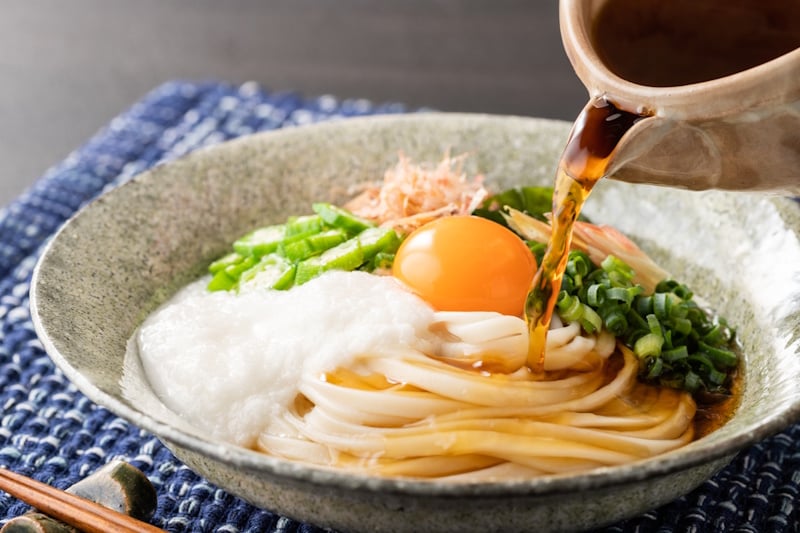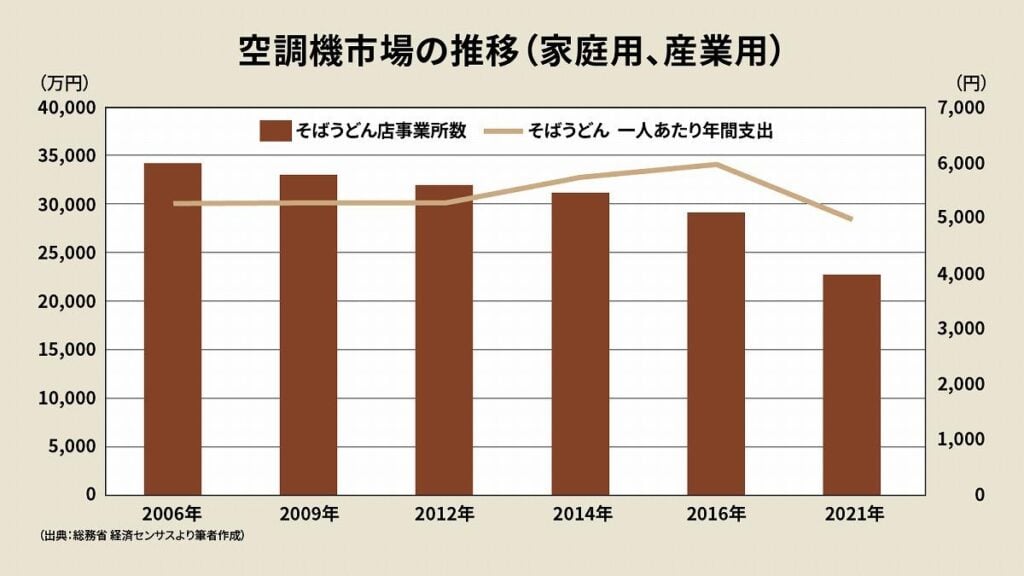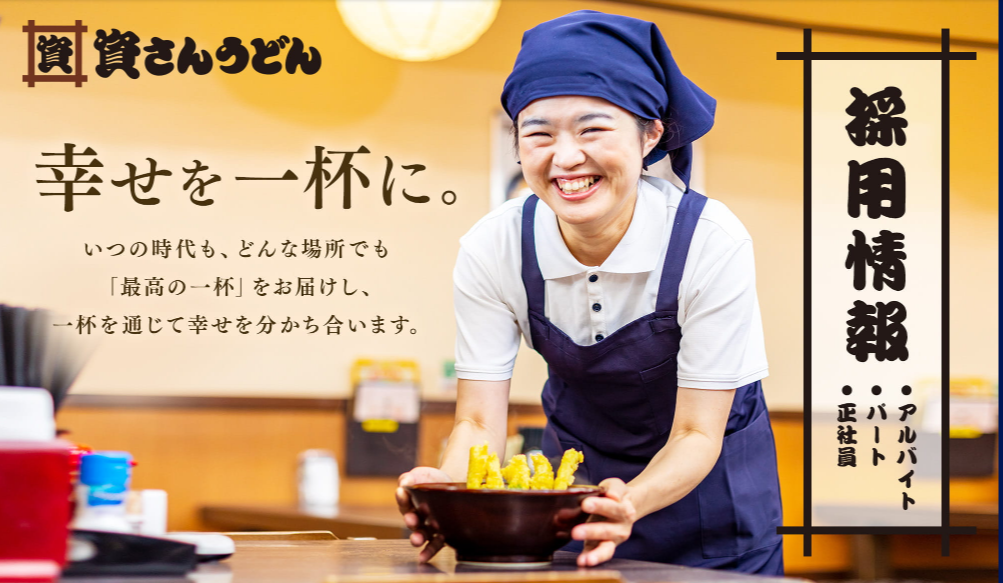Japan is famous worldwide for its food. From delicately sliced sashimi to playful, character-themed pastries, the country knows how to make a meal memorable. But if there’s one thing Japan does best, it’s noodle soups. Udon – thick noodles in a savory broth, topped with everything from meat to vegetables and eggs – is a perfect example.
In Kitakyushu, at the northern tip of Fukuoka Prefecture, udon isn’t just food – it’s comfort in a bowl. The city’s famous Sukesan Udon has long been celebrated as its ultimate soul food.
Now, after traveling all the way from its southern home, it has landed in the Kanto region, including Tokyo. And it’s already drawing crowds.
The udon effect

“Sukesan udon! I wanted to go while in Fukuoka, but thanks to the Skylark Group, I can enjoy it in the Kanto region too. What a joy!”
“I can’t believe I get to eat this in Tokyo…I’m so happy.”
“Every time I went back home, I’d always eat Sukesan Udon. I can’t believe I can eat it in Kanagawa… this is amazing.”
Founded in 1976 in Kitakyushu City, Sukesan Udon is more than just a restaurant: it’s a local institution.
Loved for its hearty udon bowls, it also serves over 100 other dishes, from curry and rice bowls to the beloved sweet rice cakes, botamochi. Affordable, filling, and open 24 hours, Sukesan has long been a comforting staple for locals, offering a cozy alternative to always-open chains like Sukiya and Yoshinoya. The true star, however, is the signature Gobo-ten udon: thick noodles in a savory broth and crispy burdock tempura that feel like home in every bite.
Sukesan’s popularity in Kyushu was so strong that it didn’t stay local for long. After being acquired by Skylark Holdings in 2024, Sukesan began expanding beyond its home region.
In December 2024, the first Kanto location opened in Yachiyo, Chiba. Crowds formed immediately, and social media buzzed with excitement. And the numbers backed up the hype: in the following month, the Yachiyo store served around 2,000 customers a day.
The momentum continued. February 2025 saw the first Tokyo branch open in Ryogoku, a prime spot within walking distance of the station and close to offices and apartments alike. Then, on August 8, 2025, the first Kanagawa location opened in Sagamihara.
Judging by the buzz – both online and in the lines outside – this is only the beginning. With growing demand and bold expansion plans, Sukesan Udon is steadily turning Kanto into its newest home, one steaming bowl at a time.
A taste of home
 Picture: w_stock / PIXTA(ピクスタ)
Picture: w_stock / PIXTA(ピクスタ)
Sukesan Udon may be the hot new arrival in Kanto, but its roots run deep.
In 1971, founder Onishi Akihisa took over a modest eatery from an acquaintance in Kitakyushu. What started small quickly became a lifeline for locals. Open 24 hours – well before convenience stores existed – the chain served a menu as broad as it was comforting.
Sukesan embodied hospitality, affordability, and heart. Even now, most meals stay under 1,000 yen, a rarity in an era of rising prices.
That formula – simple, hearty food at a fair price – explains a lot about Sukesan’s hold on Kyushu. But its magic has proven portable.
Planning a trip to Japan? Get an authentic, interpreted experience from Unseen Japan Tours and see a side of the country others miss!

“Noah [at Unseen Japan] put together an itinerary that didn’t lock us in and we could travel at our own pace. In Tokyo, he guided us personally on a walking tour. Overall, he made our Japan trip an experience not to forget.” – Kate and Simon S., Australia

See a side of Tokyo that other tourists can’t. Book a tour with Unseen Japan Tours – we’ll tailor your trip to your interests and guide you through experiences usually closed off to non-Japanese speakers.


Want more news and views from Japan? Donate $5/month ($60 one-time donation) to the Unseen Japan Journalism Fund to join Unseen Japan Insider. You’ll get our Insider newsletter with more news and deep dives, a chance to get your burning Japan questions answered, and a voice in our future editorial direction.
In July 2024, a limited-time pop-up in Kanda, Tokyo, tested the waters. With no flyers, little advertising, and hardly any name recognition in the capital, expectations were modest. Yet 400 people lined up daily, and the shop sold out every night.
“Normally, with a new brand, we hand out flyers,” Chairman Sakita Haruyoshi explained to IT Media. “But with Sukesan Udon, we judged word of mouth was strong enough.”
And that word of mouth has been powerful. Kanto is full of people who grew up in Kyushu, and for them, Sukesan is a taste of home. They brought friends, shared photos on social media, and spread the buzz.
“Whenever I attend openings, customers in Kanto often tell me, ‘I used to eat this when I was a kid,’ or ‘I brought my friends today,’” confirmed Sakita.
But beyond nostalgia or social media chatter, Sukesan’s true strength lies in what it has always offered: simple, unpretentious food that feels like an embrace. And that, perhaps, is the real reason why it has traveled so far – and why long lines in Kanto show no sign of slowing down.
A bold strategy
Sukesan Udon is clearly on the rise, but it’s doing so in a tough market. Over the past 15 years, the number of shops has steadily declined, from roughly 34,000 in 2006 to just under 23,000 in 2021. Yet per capita spending barely budged.
This shift is largely due to the rise of udon chains. As independent shops closed, these chains stepped in, capturing the customers that family-run stores once served.
 From Business + IT
From Business + IT
The biggest players, Marugame Seimen and Hanamaru Udon, both launched in 2000 with similar menus centered on udon and tempura toppings. Marugame quickly pulled ahead: by April 2024, it had 863 stores nationwide, compared with Hanamaru’s 418. Sales tell the same story, with Marugame bringing in ¥95.6 billion in FY2020, more than three times Hanamaru’s ¥30.8 billion.
Yet both chains now face a new contender: Sukesan. And competitor missteps may have helped open the door.
Hanamaru, for example, leaned heavily on discount campaigns, which eventually drew complaints about cleanliness and service. Meanwhile, Marugame has faced frequent backlash for marketing its udon as made with “domestic wheat,” despite sourcing most of it from overseas.
Sukesan’s rise, however, isn’t just about competitors’ mistakes. Its growth is rooted in a smart, practical strategy. After being acquired by Skylark Holdings, Sukesan began converting shuttered Skylark locations into new restaurants and retraining existing staff. This approach cut costs for land, hiring, and training, allowing fast, efficient expansion.
In 2018, Sukesan had just 39 stores across northern Kyushu. Today, it boasts 89 nationwide, with plans to reach 94 by the end of 2025 and 149 by 2026.
When asked about the pace – far slower than Marugame’s 800-plus stores – Chairman Sakita Haruyoshi explained: “It may seem slow, but we prefer steady, sustainable growth. By converting existing Skylark locations instead of always building from scratch, we expand efficiently while keeping quality high.”
Rising star
 Rich sesame tare udon and bitter-hot Sanratan udon are two limited-edition varieties at Sukesan Udon. (Picture: Sukesan website)
Rich sesame tare udon and bitter-hot Sanratan udon are two limited-edition varieties at Sukesan Udon. (Picture: Sukesan website)
Looking ahead, Sukesan Udon shows no signs of losing steam. With new locations focused on the Kanto and Kansai regions, and plans to open roughly 100 stores annually from 2027 onward, the chain is entering a phase of nationwide growth. Skylark CEO Tani Makoto has even set his sights on the long-term goal of reaching 1,000 stores, confirming just how big the future could be.
Planning a trip to Japan? Get an authentic, interpreted experience from Unseen Japan Tours and see a side of the country others miss!

“Noah [at Unseen Japan] put together an itinerary that didn’t lock us in and we could travel at our own pace. In Tokyo, he guided us personally on a walking tour. Overall, he made our Japan trip an experience not to forget.” – Kate and Simon S., Australia

See a side of Tokyo that other tourists can’t. Book a tour with Unseen Japan Tours – we’ll tailor your trip to your interests and guide you through experiences usually closed off to non-Japanese speakers.


Want more news and views from Japan? Donate $5/month ($60 one-time donation) to the Unseen Japan Journalism Fund to join Unseen Japan Insider. You’ll get our Insider newsletter with more news and deep dives, a chance to get your burning Japan questions answered, and a voice in our future editorial direction.
Yet what sets Sukesan apart isn’t just bold strategy or ambitious numbers: it’s the passionate community behind it. Customers who grew up with Sukesan in Kyushu have carried their love for the brand nationwide, introducing friends, sharing their experiences online, and helping the chain thrive far from home.
With flavorful food at its core, a devoted following, and a bold yet sustainable expansion plan, Sukesan could be on track to redefine the very future of Japan’s udon scene.
Sources
北九州のソウルフード「資さんうどん」 なぜ関東で行列ができるのか IT Media
北九州のソウルフード「資さんうどん」東京1号店、2025年2月24日オープン! 福岡観光WEB
神奈川県内初出店!北九州のソウルフード「資さんうどん」は「資さんうどん相模大野店」PR Times
うどん作りにかけた情熱 資さんうどん
すかいらーくHDが買収、北九州発「資さんうどん」とは何者か 大繁盛の歴史解剖 日経 X TREND
丸亀製麺には難しい?“ある需要”取り込む…北九州発「資さんうどん」が超強いワケ ビジネス+IT
丸亀製麺とはなまるうどん、どこで差が付いたのか 振り向けば「資さん」も……三つ巴の乱戦に? IT Media
資さんうどん、来年までに店舗倍増…社長「将来的には1000店まで拡大の可能性は十分ある」 読売新聞


AloJapan.com